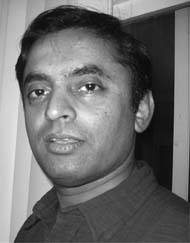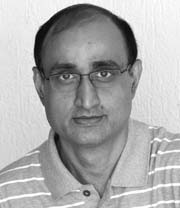- Home
- Archive -Jan 2010
- The elusive enc. . .

The elusive enchantress
- In :
- Personal Growth
January 2010
By Purnima Contoor
A recurring theme in eastern philosophy and western thought, maya, is an illusion that the individual consciousness is separate from cosmic consciousness. Maya itself manifests, perpetuates and governs this illusion of separateness or duality
test
 |
Yaa Devi sarva bhooteshu, bhranti roopena samsthita,
Namastasyei, namastasyei, namastasyei namo namaha
(Salutations to the Divine Mother who abides in all beings in the form of ‘Bhranti’ or Delusion) You are a slave, Neo, you were born into bondage, born into a prison, and you cannot smell or touch or feel. A prison for your mind,” This is not Lord Krishna holding forth on the mysteries of the universe to Arjuna in the Gita, but Morpheus, a highly evolved soul, trying to convince his new recruit, Neo, that the world he inhabits is actually a virtual world called ‘matrix’, in a Hollywood movie of the same name.
In a typically western spin to the eastern concept of maya, Matrix talks about the phenomenal universe as a simulated reality, created by sentient machines, to keep the human population subdued and in captivity, completely devoid of free will. Morpheus and his crew are a group of free humans who ‘unplug’ others from the matrix and recruit them to their resistance against the machines. The movie trilogy is all about the evolution of Neo, who realises his potential, battles the evil Agent Smith, emerges as the free spirit that he is, and releases humanity from this make-believe world.
Sounds familiar? The matrix is our world, to which we are tied in eternal bondage by the evil sentient machines – the five senses of man that give rise to anger, attachment, desire, possessiveness, greed, envy and pride. Morpheus is the higher consciousness that instigates the seeker Neo to fight the ego, Agent Smith, and ultimately be liberated from the virtual world, matrix.
It was 2000 years ago that Adi Sankara, India’s greatest philosopher and proponent of the philosophy of Advaita, described the world as ‘mithya’ or unreal. The seer encapsulated the entire message of Vedanta crisply: Brahman satyam(Brahman, the all-pervasive Cosmic Consciousness is real); jagat mithyam (the entire cosmos, gross and subtle, as perceived by our senses is unreal); and Jivo Brahmaiva napara (there is no difference between the essence of Brahman and the individual). The universe, which is one, appears to us in multifarious forms because of our ignorance, he said, and called this ignorance, nescience or maya. Sankara composed many treatises on the nature of Brahman and man, one of them being Maya Panchakam, a set of five verses which describe the effect of maya in our lives.
• Maya, says Sankara, makes the impossible happen in various ways. It superimposes the distinctions of duality on the soul, atman, which makes man believe that the world, God and the soul are separate.
• Maya makes even the most intelligent among men to behave no better than animals, by tempting them with wealth and possessions.
• Maya makes the soul identify itself with the body made up of the five elements, and whirl intensely in the ocean of transmigratory existence.
• Maya creates the notion of ‘I’ ness, creates the distinctions of caste, creed and attachment to worldly possessions and relationships, whereas the nature of the soul is pure bliss.
• Maya also creates the distinctions of different godheads like Brahma, Vishnu and Shiva in the undivided universal consciousness, and thereby perplexes even the learned by making them look upon the three energies as different from one another.
A comprehensive description that cannot be improved upon!
 The serpent or the rope? The serpent or the rope? |
The illusion of maya
‘Maya’ is thus a recurring theme in eastern philosophy and western thought. The Buddha called the world a mirage. All the world is a stage, said Shakespeare in As You Like It, “… men and women are but actors who have entries and exits; and one man plays many parts, his act being seven ages”. A lovely statement that rolls glibly off our tongues, but is it easy to internalise its philosophy? The predicament of humanity is like the actor playing the role of a beggar, who continues to beg even when the director says ‘pack up’, forgetting that he has a Mercedes waiting to whisk him away to his mansion.
Forgetting that we have the wealth of sat-chit-ananda or pure bliss inside us, which our Creator in utter compassion packed inside us when we were born, we seek satisfaction and pleasure in our external world through family, relationships, career, fame, fortune, health, wealth and prosperity. With these conquests, we do experience happiness and joy, but only for small periods because these feelings are directly proportional to our achievements and possessions.
The external quest is an endless one that cannot quench the thirst of the soul. A renunciate once found a hole in his loincloth. The sanyasi figured mice were at play in his hermitage, and acquired a cat to catch the mice. He needed to feed his cat, so he got a cow that could give him milk to feed the cat. He found that the cow needed to be taken care of, so he acquired a wife who could do that. No prizes for guessing what happened next! Caught in the vortex of samsara, the sanyasi abandoned his inner quest in favour of the outer.
Like this sanyasi, we go on acquiring possessions hoping they will give us happiness, but find ourselves ultimately possessed by the possessions. To get out of this vortex, we first need to understand how maya came about in the first place, and therein lies a fascinating tale!
The mechanics of maya
The word ‘maya’ is derived from the Sanskrit root ‘ma’ (that) and ‘ya’ (not). ‘ma’ also means ‘to measure, to limit, to give form’. Maya can thus be taken to mean ‘that which is not’. The scriptures say that there is a fundamental flaw in the way the universe is perceived by man. An individual sees everyone and everything in the universe as having separate identities, and experiences ‘reality’ with respect to a time frame and space. This is nothing but a severely crippled and limited projection of the mind governed by the ego, which does not allow individual consciousness to perceive the highest reality where there is no duality. This illusion that the jeevatma (individual consciousness) is separate from paramatma (Cosmic Consciousness) is termed maya.
Thus, maya is the principal concept, which manifests, perpetuates and governs this feeling of separateness or duality, which is actually an illusion. Even the concept of time and space itself is a projection of maya, ‘That which is not’. For non-dualists, maya is not an illusion but a relative reality, in contrast to the absolute, unchanging reality.
Everything that man experiences in the waking, dreaming and deep sleep states is called maya.
Brahman or Cosmic Consciousness or the Self is the unmanifest, pure, primordial, formless energy existing in infinity. When this energy decided to manifest, the process of maya began.
Different schools of thought have different names for this primordial energy. Vedanta calls it ‘Brahman’, Sankhya philosophy calls it ‘Purusha’, Yoga calls it ‘Atman’, Buddhism terms it ‘Shunya’ and Aristotelian philosophy calls it ‘Pure Potential’. The Shaktas (worshippers of Shakti) call it ‘Aadiparashakti’; the Shaivaites (worshippers of Shiva) call it ‘Paratpara Shiva’; the Vaishnavites (worshippers of Vishnu) call it ‘Parabrahma’. Other recent schools of philosophy like the ISKCON call it ‘Krishna or Christ Consciousness’.
The not-self or the manifest energy in the phenomenal world is called ‘prakriti’ in Sankhya and Vedanta. For this formless unmanifest energy to manifest with form, a number of ‘tattvas’ or attributes, the building blocks that act as raw materials came into being. Twenty-four to thirty-six of such tattvas are specified in the scriptures depending on these schools of thought.
Prominent among these attributes are:
• The panchabhutas or five elements (earth, water, fire, air and ether)
• The five tanmatras or subtle mediums of sensation (sense of smell, taste, sight, touch and sound)
• The corresponding five jnanendriyas or sense organs (nose, tongue, eyes, skin and ears)
• The five karmendriyas or organs of action (hands, feet, organs of speech, reproduction, excretion)
• The antahkarana or five inner instruments (mind, ego, intellect, the principles of male and female)
• The sat kanchukas or six limitations (time, space, desire, knowledge, power, illusion – maya)
Thus, maya, we can see, is part of the very building block of the universe, as the verse at the beginning of this article suggests. The devi stuti hymn in praise of the divine mother says that the Divine is in our very DNA in the form of delusion itself.
Scriptures also hold that it is the divine mother, called Mahamaya, who causes Lord Vishnu to close his eyes in yoga nidra or deep slumber, so that he can dream his cosmic dream uninterrupted!
Ramakrishna Paramahamsa, the great devotee of Goddess Kali, called maya the mysterious and majestic expression of divinity. He called the divine mother the mighty weaver who was like “…the effulgent sun, bringing into existence clouds of different colours and shapes, shining through, standing behind them and thus conjuring up wonderful forms in the blue autumn heaven’.
Echoing these sentiments, wildlife photographer Vijay Cavale feels the hand of maya in nature – in the weave of a spider’s web that traps its prey and the effortless flight of birds that welcome dawn and herald dusk. “For a ‘nature bhakta’ like me, it is so easy to acknowledge the presence of God,” he says. “There is maya in everything I see! What else can bring you more joy than this maya embracing you, caressing you, singing you a lullaby and eventually consuming you?”
Thanks to maya, we experience this wonderful world, and thanks to maya, we undergo suffering. Maya thus enthrals, and also baffles. “The world around me is so extant, concrete and realistic,” says Kiran Bettadpur, entrepreneur from US. “Yet, ironically, as and when the conscious in me escapes, the universe is totally non-existent to me and my awareness! So, the question is, ‘does my awareness exist because I exist; or do I exist because my awareness exists?’” he asks rhetorically.
Until we make a conscious effort to understand the nature of creation, we will continue to create and experience our own reality. Only through sadhana can we reach the escape velocity enough to propel us out of this delusion and into the reality of Brahman.
 “It’s not the spoon that bends, it’s only yourself.” Neo, from the Matrix “It’s not the spoon that bends, it’s only yourself.” Neo, from the Matrix |
How does maya work?
The manifestation of maya in our lives is scientifically codified in our scriptures. Maya acts at two levels called ‘avarana’ and ‘vikshepa’. Avarana refers to the veiling of the truth, and vikshepa to the illusion caused due to this veiling. The terms are best explained by resorting to the most common and oft-quoted example of illusion given by Adi Sankara in Atma Bodha.
In poor light, a rope lying on the ground can be mistaken for a snake by an individual. This illusion mistaken for reality is avarana – the truth that the object is indeed a rope and not a snake is veiled. Then vikshepa follows – the fear arising out of the belief that the rope is a snake, caused by this illusion. Thus, the reality of the rope is enveloped by the false reality of the snake created by the hallucinating mind.
Swami Chinmayananda has a delightful story to drive home the effect of avarana and vikshepa. In a large field lived a family of mice, happy with their cosy and exclusive environs. Their idyllic life was disturbed when a donkey started frequenting the field, foraging for food and roaming around. The large animal, unable to see the little holes in the ground, often trod on them, destroying their home and at times harming and killing their offspring.
The mice couple hatched a plot to drive the donkey out of the field. One of them confronted the donkey one day and challenged him to a running race. Amused by the ignorant little mouse daring him to run a race, the donkey readily agreed. The race started, both bound by the condition that the loser would leave the field. The donkey ran fast, but to his amazement, always found the mouse ahead of him. He was unaware that the mice were playing a trick on him, and two of them were managing in turns to stay ahead of him. Admitting defeat, the donkey left the field.
The avarana or veiling of the truth here is that the donkey thought that there was only one mouse, whereas there were two. The vikshepa, the effect of this avarana, was that the donkey was deluded that the mouse could indeed run faster than he could and admitted defeat.
In life, most of us are victims of avarana and vikshepa almost on a daily basis. Our reactions to situations tend to be shortsighted, selfish and based on extremely limited knowledge available at the moment. In total ignorance, we do not even entertain the possibility that there might be a bigger angle to things. Phanibhushan Sharma, director of a software company in Bangalore, has an anecdote to share with which most of us can identify:
“I was on a flight from Paris to Mumbai in the early years of this decade, and I had a co-passenger occupying the window seat. The aircraft took off and the on board services started. A hostess came and offered us all a drink. The co-passenger just glanced at her and turned away. The hostess came up the second time and again asked the fellow if he wanted something to drink. Again, he looked at her and turned away! I thought that it was a very strange and rude behaviour on his part.
“This continued for the length of the flight, with the man resisting and worse, ignoring our every effort to help him. He displayed no emotions – I concluded that he was dumb and/or heavily drugged and/or travelling for the very first time on an airplane and hence was anxious.
“Finally, it was time to alight at Mumbai. I got up to retrieve my luggage from the overhead bin, when this man spoke to me, ‘Sir, sorry for being rude, I have lost my wife and both my children in a ghastly accident and I have to rush.’”
“If ever I meet this person again,” laments Phanibhushan, “I will fall at his feet and beg forgiveness!”
The avarana here was that the man’s background was veiled and thus Phanibhushan had no clue about the reason for the man’s behaviour. The vikshepa – with the available data, based on the way the man behaved during the short duration of the flight, was branding the man as rude/dumb/nervous.
For man, the truth that the world is a relative reality is veiled – avarana. The vikshepa is that man believes that life on earth is all there is and does all he can to secure his physical well-being, forgetting that the soul and not the body, is immortal. Like King Hussein I, the father of modern Jordan, says, “Those who are visited by fear live only for their present, under the illusion that the world began with them and will end with their departure.”
In spiritual terms, the mind, enveloped by maya, prevents the awareness of the Self – avarana. As our consciousness is thus veiled, we become incapable of knowing our true nature – vikshepa.
 Kiran Bettadpur ‘When the conscious in me escapes, the universe is totally non-existent to me and my awareness.’ |
Maya experienced
For a fish to understand something other than water, it first needs to be aware that there is something else, which is not water, and next, it needs to come out of water to seek the other. This is the fate of man, so immersed in maya that the very fact that there is a higher reality is clouded.
Linda Goodman says that we often forget that we are spiritual beings having a human experience and not vice versa. Mythology talks about Jaya and Vijaya, the two guards of Lord Vishnu at Vaikunta. Due to a curse, they are born on earth as sworn enemies of their beloved Lord in three lifetimes. The duo is born as Hiranyaksha and Hiranyakashipu as enemies of Lord Vishnu, Ravana and Kumbhakarna as enemies of Lord Rama, Shishupala, and Dantavakra as enemies of Lord Krishna. In all three lifetimes, they completely forget their real identity as the Lord’s most trusted divine guards and go about living a life in total contradiction to their real selves. In arrogance born out of ignorance, they go about wreaking havoc on earth as anti-gods. After their cup of karma overflows, they are vanquished by Lord Vishnu who incarnates as Narasimha, Rama and Krishna respectively to kill the duo in different eras.
This puranic tale captures the effect of maya on an embodied soul to perfection. All of us are Jayas and Vijayas, divine souls, who the Lord holds very dear. As we are sent to earth, embellished by the 30 odd tattvas of which maya is one, we completely forget our divine nature. Propelled by the ego, we develop the feeling of I, me, mine – my body, my mind, my sentiments, my comfort, my family, my house, my job, my money, my language, my caste, my religion, my country, my world – in the process we grow deep roots in our temporary home. Only the knowledge of the self can vanquish our ego and liberate us from delusion.
On a trip to earth, sage Narada asked Lord Vishnu about this phenomenon called maya, which makes people forget the Lord. Vishnu asks Narada to have a dip in a lake and then receive the answer. Happy, Narada plunges into the lake, and beholds a lovely maiden. He falls in love with her, gets married, begets children, goes through the nitty-gritty of raising a family, becomes poor, gets abandoned, and, totally enveloped in samsara, forgets Narayana! When he is overcome by problems, he calls out to God and is immediately pulled out of water. Narada finds the Lord waiting for him, laughingly asking him if he enjoyed the dip in samsara and a taste of maya. The sage, who breathed ‘Narayana, Narayana’, had completely forgotten to do so as an embodied soul.
What was just one moment in Vaikunta, the time it took Narada to take a dip, turned out to be a lifetime on earth for the hapless sage! Maya thus binds us in time and space that propel us into an entirely different reality, making us forget our true nature and purpose of life, which is liberation.
 Vijay Cavale Vijay Cavale‘There is maya in everything I see! What else can bring you more joy than this maya embracing you, caressing you, singing you a lullaby and eventually consuming you?’ |
Maya unveiled
The scriptures have also given us several methods to overcome maya. Dhyana, jnana and bhakti yoga are the prominent ones. Developing the ‘sakshi bhava’ or witness attitude is another path tread by realised masters.
“If people could see Earth from up here, see it without those borders, see it without any differences in race or religion, they would have a completely different perspective,” says Anousheh Ansari, an Iranian businesswoman who had the rare chance of seeing earth from space from an international space station. The distance will make our own problems on earth seem petty and insignificant, and probably put an end to man-made ills.
Similarly, if we can put a distance between our experiences, and us, we become a witness. This paradigm shift in the way we perceive the universe and ourselves is described as the ‘sakshi bhava’ or the ‘witness attitude’. If we can constantly monitor our thoughts, speech and action every moment, missing nothing, we can “…discover all that we are not,” says Nisargadatta Maharaj. Just as Socrates discovered when he started observing his sensations as he was poisoned. As the poison took effect, the great philosopher felt his body deadening and mind numbing, yet he felt another force in him that was aware of all that was happening at the physical and mental level – the witness.
Satya Sai Baba has a simple analogy for this. Our shadow follows us everywhere. It falls on and gets dragged on uneven surfaces, on rocks and rough terrain, mud and mire, thickets and thorns – but our body is not affected, as we know that we are not our shadow. We are a witness vis-à-vis the shadow. Similarly, the soul is not the body, nor the mind, nor the senses and sense experiences, and thus is always pure and unaffected by physical and mental experiences. Realising this is to become a witness.
Most of us have felt a sort of disassociation with what is happening to and around us when things go out of control, during moments of intense pain and joy. Life then moves in slow motion with muted sound, as they show in movies. “When my husband’s dead body was brought home in a coffin one day,” says the widow of a young army major posted in the Kashmir valley to fight insurgency, “It felt unreal. I do not know how I went through the motions for the next couple of months. I felt it was not happening to me. No, I was not living in denial. I felt pain, sorrow, anger and frustration, but I pulled through it all remarkably unscathed. At the back of my mind, I somehow had the knowledge that this was not the ultimate, and that this phase too would pass. The life I had with my husband now seemed like a dream, but it felt very real back then. Who knows whether this moment is a dream or reality? ” she says.
 King Hussein of Jordan King Hussein of Jordan‘Those who are visited by fear live only for their present, under the illusion that the world began with them and will end with their departure.’ |
When this ‘disassociation’ with life arises out of viveka or discrimination, it is permanent knowledge that takes us out of this cycle of births and deaths. The pursuit of viveka is called jnana marga. The way out of maya is through dhyana or meditation, says Patanjali’s Yoga Sutras. Complete surrender or sharanagati to a sadguru is the path suggested by bhakti yoga. All these paths lead us to the state beyond maya called ‘turiya’, the state above the waking, dreaming and deep sleep states.
Working with maya
While there are many who tread the path of liberation purely by their own effort and grace, a la Osho, most people find their paths speeded by the presence of a guru by exercising surrender. When we surrender all our thoughts, words and deeds either to the guru or to God, we will be totally rid of the sense of doership. Once that happens, we will automatically not accumulate any karma, good or bad. Once we are rid of karma, we will be rid of the cycle of birth and death. Once we are rid of rebirth, we are rid of maya!
Beyond maya
One might ask, what will happen once you are out of maya. Will the world cease to exist? Only an enlightened master can answer that question, and Osho does that in the book The Discipline of Transcendence. In a vivid description on how it felt to be out of maya one fine day in March 1953, Osho says, “Since that day (of my enlightenment) the world is unreal. Another world has been revealed. When I say the world is unreal, I do not mean that these trees are unreal. These trees are absolutely real – they exist in God, in absolute reality. But, the way you see these trees is unreal. You are seeing something else, a mirage. My world is real, tremendously beautiful, luminous with infinity, it is light and delight, it is a celebration. It can be yours too if you drop your dreams.
“That night was a date with death and God simultaneously. That night for the first time I understood the meaning of the word maya.
“The whole day was strange, stunning, and it was a shattering experience. The past was disappearing, as if it had never belonged to me, as if I had read about it somewhere, as if I had dreamed about it, as if it was somebody else’s story I have heard and somebody told it to me. I was becoming disconnected from my past, I was being uprooted from my history, and I was losing my autobiography. I was becoming a non-being, what Buddha calls anatta. Boundaries were disappearing, distinctions were disappearing, mind was disappearing, it was millions of miles away. There was no urge to remain continuous with the past.
“That night another reality opened its door – the other reality, the separate reality, and the really real – call it God, call it truth, call it dhamma, call it Tao, or whatsoever you will.”
Purnima Coontoor is a Mass Communications professional from Bangalore, freelancing as a writer, editor, translator and teacher, an Osho admirer and lover of life!
To read these articles online and post your comments
We welcome your comments and suggestion on the article. Post your comments here and / or Mail us at editor@lifepositive.net
To read more such articles on personal growth, inspirations and positivity, subscribe to our digital magazine at subscribe here
Life Positive follows a stringent review publishing mechanism. Every review received undergoes -
- 1. A mobile number and email ID verification check
- 2. Analysis by our seeker happiness team to double check for authenticity
- 3. Cross-checking, if required, by speaking to the seeker posting the review
Only after we're satisfied about the authenticity of a review is it allowed to go live on our website
Our award winning customer care team is available from 9 a.m to 9 p.m everyday
The Life Positive seal of trust implies:-
-
Standards guarantee:
All our healers and therapists undergo training and/or certification from authorized bodies before becoming professionals. They have a minimum professional experience of one year
-
Genuineness guarantee:
All our healers and therapists are genuinely passionate about doing service. They do their very best to help seekers (patients) live better lives.
-
Payment security:
All payments made to our healers are secure up to the point wherein if any session is paid for, it will be honoured dutifully and delivered promptly
-
Anonymity guarantee:
Every seekers (patients) details will always remain 100% confidential and will never be disclosed
